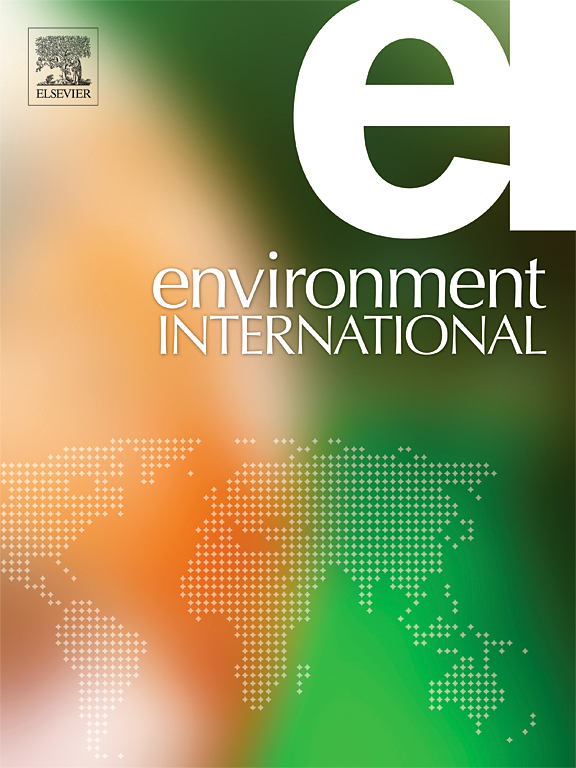妊娠尿酚生物标志物浓度与血清炎症细胞因子水平的关系:来自EARTH研究的结果
IF 10.3
1区 环境科学与生态学
Q1 ENVIRONMENTAL SCIENCES
引用次数: 0
摘要
关于孕期母体酚暴露与炎症之间关系的证据有限且不一致。目的评价尿酚生物标志物与妊娠期血清炎症因子的相关性,并探讨其在妊娠期是否存在差异。方法我们纳入175名来自马萨诸塞州总医院生育中心并参与环境与生殖健康(EARTH)研究(2005-2017)的孕妇,收集8种酚类生物标志物和血清炎症生物标志物、高敏c反应蛋白(hsCRP)和白细胞介素-6 (IL-6)浓度的现有数据。线性回归模型用于评估单个苯酚生物标志物浓度与对数转化炎症细胞因子水平之间的关系,而贝叶斯核机回归(BKMR)模型用于评估苯酚生物标志物混合物。根据样本收集的三个月进一步分层分析。结果总体上,尿对羟基苯甲酸乙酯与血清hsCRP呈正相关(β: 0.464;95 % ci: 0.012, 0.917)。在妊娠期特异性分析中,尿对羟基苯甲酸丁酯与hsCRP呈正相关(β: 0.533;95 % CI: 0.006, 1.059),但与IL-6呈负相关(β: - 0.613;95 % CI:−1.062,−0.164)。尿双酚A与hsCRP呈负相关(β:−0.428;95 % CI:−0.731,−0.125)。结论:我们的研究结果表明,暴露于某些酚类物质可能会破坏妊娠期间的炎症谱,其影响随妊娠三个月的不同而不同。这些新的关联强调了在评估环境风险因素对孕产妇和后代健康结果的影响时,暴露时间的重要性。本文章由计算机程序翻译,如有差异,请以英文原文为准。
Pregnancy urinary phenol biomarker concentrations in relation to serum levels of inflammatory cytokines: Results from the EARTH study
Background
Evidence on the association between maternal phenol exposure and inflammation during pregnancy is limited and inconsistent.
Objective
To evaluate associations between urinary phenol biomarkers and serum inflammatory cytokines across pregnancy, and to examine whether associations vary by trimesters.
Methods
We included 175 pregnant women from the Massachusetts General Hospital Fertility Center and participating in the Environment and Reproductive Health (EARTH) Study (2005–2017), with available data on urinary concentrations of eight phenol biomarkers and serum inflammatory biomarkers, high-sensitivity C-reactive protein (hsCRP) and interleukin-6 (IL-6). Linear regression models were employed to assess the association between individual phenol biomarker concentrations and log-transformed inflammatory cytokine levels, while Bayesian Kernel Machine Regression (BKMR) models were utilized to evaluate phenol biomarker mixtures. Analyses were further stratified by the trimester of sample collection.
Results
Overall, detectable urinary ethylparaben was positively associated with serum hsCRP (β: 0.464; 95 % CI: 0.012, 0.917). In trimester-specific analyses, urinary butylparaben was positively associated with hsCRP (β: 0.533; 95 % CI: 0.006, 1.059) in the first trimester, but negatively associated with IL-6 (β: −0.613; 95 % CI: −1.062, −0.164) in the second trimester. Urinary bisphenol A was inversely associated with hsCRP (β: −0.428; 95 % CI: −0.731, −0.125) in the third trimester.
Conclusions
Our findings suggest that exposure to certain phenols may disrupt inflammatory profiles in pregnancy, with effects varying by trimesters. These novel associations underscore the importance of exposure timing when assessing environmental risk factors for maternal and offspring health outcomes.
求助全文
通过发布文献求助,成功后即可免费获取论文全文。
去求助
来源期刊

Environment International
环境科学-环境科学
CiteScore
21.90
自引率
3.40%
发文量
734
审稿时长
2.8 months
期刊介绍:
Environmental Health publishes manuscripts focusing on critical aspects of environmental and occupational medicine, including studies in toxicology and epidemiology, to illuminate the human health implications of exposure to environmental hazards. The journal adopts an open-access model and practices open peer review.
It caters to scientists and practitioners across all environmental science domains, directly or indirectly impacting human health and well-being. With a commitment to enhancing the prevention of environmentally-related health risks, Environmental Health serves as a public health journal for the community and scientists engaged in matters of public health significance concerning the environment.
 求助内容:
求助内容: 应助结果提醒方式:
应助结果提醒方式:


